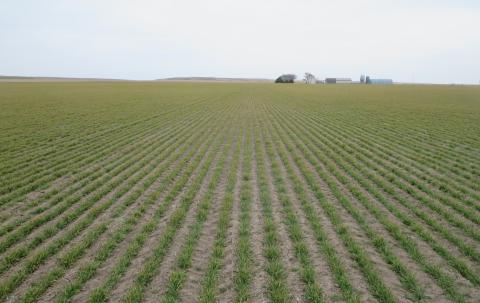Are Your Soybean Plants Exhibiting Dicamba-Induced Leaf Injury?
July 19, 2018
Learn how to examine plant development and use this forensic strategy to determine the approximate calendar date when the plants in your field were likely exposed to dicamba.
Post-harvest Weed Control in Winter Wheat
July 11, 2018
Consider using split herbicide treatments to provide extended control of weeds after winter wheat harvest. Timely weed control can limit soil moisture loss to weeds, prevent the deposit of more weed seeds in the soil, and reduce the spread of wheat streak mosaic disease.

Mid-Season Hail Damage Assessments in Corn and Soybeans
June 25, 2021
When severe storms and hail hit your corn and soybean fields, it's important to estimate yield losses to determine the need for future inputs and alternative management strategies. This guide offers steps to evaluate mid-season hail damage and estimate potential yield losses.
Considerations for Postemergence Dicamba-based Herbicide Applications to Corn
May 31, 2018
With postemergence herbicide applications occurring to corn, consider these best management practices to improve results and reduce the potential for off-target injury from your dicamba application.
Winter Wheat Progress Across the State
April 26, 2018
Winter wheat in the Nebraska Panhandle continues to be rated above average with most of the wheat rated good to excellent. Winter wheat in the west central, south central, and eastern areas is more varied, as described in this wheat progress and condition report.
The Good, the Bad, and the Ugly when Spraying the New Phenoxy Herbicide Formulations
January 8, 2018
The new phenoxy herbicide formulations offer growers new management options along with new application requirements that need to be carefully adhered to maintain their efficacy. This is an article from the Proceedings of the 2018 Nebraska Extension Crop Production Clinics.
Controlling Weeds in and Fertilizing Winter Wheat, Particularly Late-Seeded Fields
March 15, 2018
With many wheat fields planted later than normal due to rain, stands are not as competitive with weeds and younger plants may be susceptible to herbicide injury, making a good weed management plan even more important this year.
Potential Off-Target Dicamba Movement from Corn Applications
February 15, 2018
While the new soybean dicamba herbicides were often blamed for injury to sensitive plants in 2017, a deeper look at the timing of injury and the weather conditions at those times suggests dicamba applications in corn may have contributed to plant injury in many areas. Increased management for all dicamba applications will be needed in 2018.






